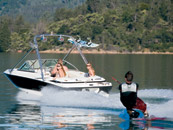 Just like any piece of sporting equipment, there are lots of considerations to make when choosing a wakeboard. There are plenty of options for everything from where you buy it (board shop or Internet) to board length (too short or too long can affect your ride) to cost (based on your skill level and goals). But having lots of choices will ultimately make your wakeboard-buying experience as much fun (almost) as a day on the lake.
Just like any piece of sporting equipment, there are lots of considerations to make when choosing a wakeboard. There are plenty of options for everything from where you buy it (board shop or Internet) to board length (too short or too long can affect your ride) to cost (based on your skill level and goals). But having lots of choices will ultimately make your wakeboard-buying experience as much fun (almost) as a day on the lake.
Here are some of the key things you need to decide as you narrow down the options for your new wakeboard. Some choices (length, for instance) affect several other components such as weight, so expect to make some tradeoffs along the way. That’s especially true if you get your heart set on a certain graphic, because many times different designs go with separate board styles and may not be on the board that fits your needs.
How Much Should I Expect To Spend?
This really depends on your financial situation, and how much time you expect to spend on the board, realistically. There are plenty of great introductory boards that will help you master the basics of wakeboarding. If you find you’re sticking with the sport and are working up into a higher skill set of tricks, then it might be time to move into a more appropriate board. You might be able to find used boards locally through Craigslist or local classified ads if your budget is really tight. If you need someone to help you through the process, however, a watersports specialty shop or Internet site may be your best bet. Many board shops may even offer a demo plan, so you can try it before you buy it. Expect brand-name boards to run from about $150 to $500.
What’s the Right Length?
The general rule of thumb is that heavier riders need longer boards. That may not always be the case, but it’s a good starting point. Just remember there are other factors such as width and weight to consider. If the board is too big, you may have a hard time riding and an even tougher time launching up in the air for tricks. On the other hand, if you have a board that’s too small, you may not have enough surface area to keep you on top of the water while riding.
How Do I Decide The Proper Width?
There are a couple of things to consider regarding the width of a wakeboard. The more tapered the end of the board, the better it will turn, but the more limited you are with tricks that require launching off the wake. The wider the middle of the board is, will help you launch more easily, but will be tougher to turn in normal riding conditions. With most boats, with a small wake, you would be better off with a board that’s slightly more narrow. If you will be riding behind a dedicated wakeboard boat that carries a lot of weight and creates a large wake, go with a wider board. That will also help your soften your landings.
How Do the Fins Affect My Ride?
Riders often refer to fins on the bottom of a wakeboard while describing the difference between a “loose” ride and a “tight” ride. Whether the fins are bolted in or molded into the board, they essentially serve the same purpose. The bigger the fins, the more surface you’ll have in the water, and the more ability you’ll have to cut and turn sharply in the water. Small fins will have less surface in the water, and you’ll have to lean into your edge more while turning. Generally speaking, most beginners will find the stability of larger fins easier to use while learning. Higher-end boards may actually come with several sets of fins that you change out as your skills improve. It also helps to cushion your landings.
The final consideration to make (usually the first thing that catches your eye) is the graphics. There are several big-name wakeboard manufacturers that constantly compete to come up with wild new designs. That’s part of the fun! Just make sure that you get the right board set up that matches your riding style. That way, you can really enjoy the sport and spend time out on the water improving your skills.
For more information, read these 10 Tips for Choosing a Wakeboard.

